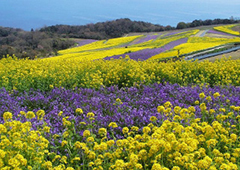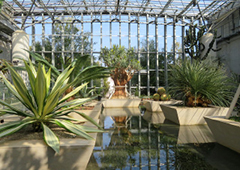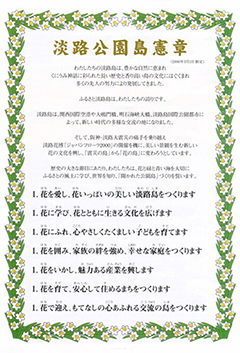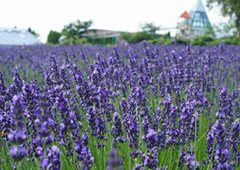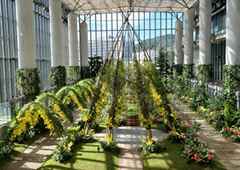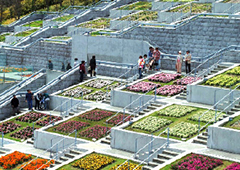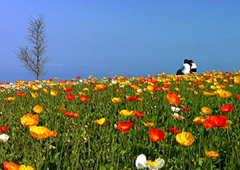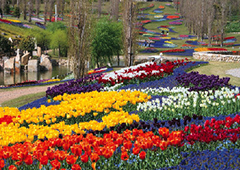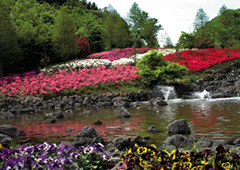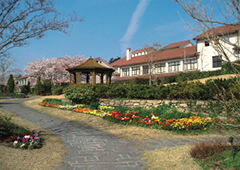Awaji Island Kuniumi Association
- Top
- Nature & Flower
Nature & Flower
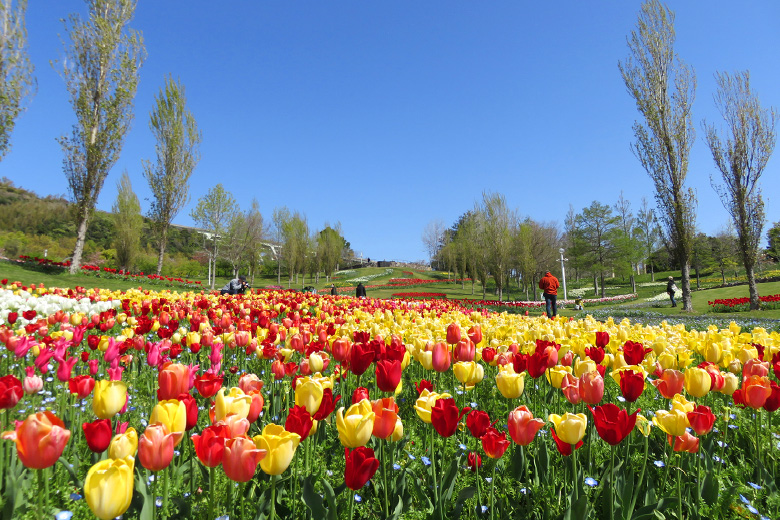
Akashi Kaikyo National Park
In "Kojiki" and "Nihon-Shoki", the books of the Japan ancient times, Awaji Island is written as the island which was born first in the world. As such, the Awaji Island has magnificent histories and cultures which are backed up with the great "Kuniumi Shinwa", the myth about the birth of the land of Japan.
This land has been extremely rich in nature, and had been called "Miketsukuni", the region which provided special products such as foodstuff to the Emperor and the Imperial Court from the ancient times through the Heian era. The islanders also had enjoyed the benefits of such nature. They have occasionally felt the gratitude for the blessings of nature and expressed their thankfulness in the culture of "Matsuri" or "festivals".
In this way of life, the spirit of our predecessors who cherished nature has been handed down from generation to generation since ancient times.
Awaji Island Park
Since far back in time people have lived harmoniously with nature on Awajishima. That spirit of harmony lives on today among Awaji islanders.
Expanding on the theme, "Awajishima, the Island of Parks," we aim to usher in a new age of pride on the island in which people feel spiritually reconnected to their countryside origins, creating new hope for the future.
The O-Naruto Bridge was completed in 1985, followed by the Akashi-Kaikyo Bridge in 1998. These bridges now enable Awaji Island to connect Shikoku to the mainland of Honshu. The island has become a symbolic meeting point for cultural exchange.
In March 2000, the "Island Park Awaji Charter" was established to reinvent Awaji as an island of parks featuring flowers and greenery.
Awaji Island was the the epicenter of a major earthquake in 1995. Now, various efforts are being made to promote floral culture on Awaji. We are succeeding in creating a new image for the island as a place to visit to enjoy flowers and beautiful scenery.
Activity
Awaji Flower Pilgrimage (Awaji Hana Henro)
An Awaji Flower Pilgrimage has been created, inspired by the well-known 88-temple pilgrimage of Shikoku. "Flower pilgrims" will discover the many charms of Awaji by traveling from site to site, viewing flowers or beautiful scenery, or enjoying other attractions around the island. The tour, which consists of 74 select spots at present, gives visitors the chance to relax, enjoy, and also interact with local islanders.
Related information
Awaji Yume Butai: Botanical Gardens AWAJI GREENHOUSE
This is one of Japan's largest greenhouses, with an area of 6,700 m2. Various flower shows are held here on the theme of harmony between people and nature. The greenhouse has a garden space with many rare plants from around the world on display.
Awaji Yume Butai: Hyakudan-En(100 Platform Terrace Garden)
Flower beds are arranged on a terraced hillside slope, with 100 connected sections in all. Each section has an area of 4.5 m2. All year round plants and flowers from around the world in the composite family are on exhibit.
Awaji Flower Gallery (Awaji Hana Sajiki)
Enjoy a panoramic view of the Akashi Straits and Osaka Bay from a hilltop covered in flowers. In spring: mustard blossoms; in the summer: verbena; and in the autumn: cosmos. Visitors can enjoy a different mood in every season.
Akashi Kaikyo National Park
The park changes beautifully from season to season. In spring the 300 varieties of tulips and 600,000 bulbs are a spectacular sight. Fun nature events are held all year round, including the Awaji Flower Festival (Awaji Hanahaku) in spring and autumn.
Awaji Island Prefectural Park
This expansive 71.7-hectare municipal park is set on a hilltop overlooking the Akashi Straits. It includes a forested area for taking walks and a playground area that children will love -- perfect for relaxing family outings.

